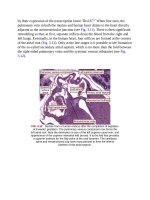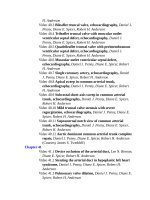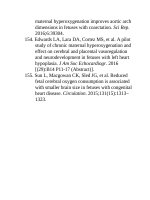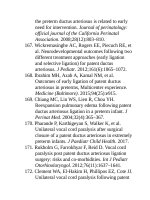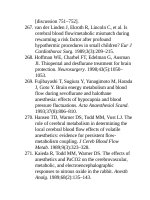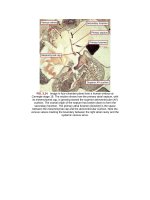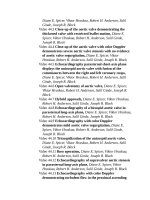Andersons pediatric cardiology 1083
Bạn đang xem bản rút gọn của tài liệu. Xem và tải ngay bản đầy đủ của tài liệu tại đây (127.65 KB, 3 trang )
Theseauscultatoryfindingsareonlyforanuncomplicatedpersistentductina
child.Itshouldberememberedthatthesefeaturesmaydifferininfancyorbe
alteredbythedevelopmentofcomplications.
Investigations
Electrocardiogram
Patientswithanisolatedpersistentarterialductusuallyhavesome
electrocardiographicevidenceofleftatrialandventricularhypertrophy,
reflectingvolumeoverloadoftheleftheart.Occasionally,theelectrocardiogram
mayshowcombinedventricularhypertrophyor,iftheductissmall,beentirely
normal.Theelectricalaxisisusuallynormal,anddeviationtotheright,with
rightatrialand/orrightventricularhypertrophy,suggeststhepresenceof
additionaldefectsorpulmonaryhypertension.Theelectrocardiographicchanges
arelesspredictableininfantsandclinicallylesshelpful.56Prolongationofthe
PRinterval,whichdisappearsordecreasesafterclosure,hasbeenobservedin
about20%ofcases.57Atrialfibrillationmaydevelopinadultlife.58,59Whenthe
shuntislargeenoughtoequalizethesystemicandpulmonaryarterialpressures,
biventricularhypertrophyislikelytodevelop.Withtheonsetofpulmonary
vasculardisease,thepredominantfindingswillbethoseofrightventricular
hypertrophy.
ChestRadiography
Thechestfilmmaybenormalinpatientswithasmallshunt.Cardiomegalyis
presentinthosewhereflowtothelungsisclosetotwicesystemicflowor
greater.Increasedpulmonaryvascularmarkingsareseen,withanobviousbulge
ofthepulmonarytrunkattheleftborderofthecardiacsilhouette.Theaortais
alsoprominent.Bothitandthepulmonarytrunktendtoenlargewithage.
Enlargementoftheleftatriumisusuallypresentandreflectsincreased
pulmonaryvenousreturnduetotheleft-to-rightshunt.Increasedpulmonary
vascularitymaybemoremarkedontheright,asisoftenseenwithotherleft-torightshunts(Fig.41.11).Theductmaycalcify,althoughthiscomplicationis
morecommonwhenthevesselisclosedratherthanpatent.Theaorticendofthe
duct,theductalampulla,maybeseenonthechestradiographandcanbe
demonstratedangiographicallyduringthefirstweekoflife.Thesefindingsmay
bemodified,especiallyifpulmonaryvasculardiseasedevelops.
FIG.41.11 Chestradiographsfrompatientswithsmallducts.Left,Note
theminimallyincreasedpulmonaryvascularity.Right,Childwithalarger
ductalcommunication.Thereisincreasedpulmonaryvascularityand
cardiomegaly.
Echocardiography
Persistentpatencybeyondtheneonatalperiodisreadilydiagnosedfromthe
characteristicclinicalfeatures.Cross-sectionalechocardiographywillhelpto
ruleoutotherstructuralcardiacmalformations.Theductcanbeimaged
throughoutitslengthusingahighleftparasternalview,60,61allowingevaluation
ofductalsizeandthepresenceoftissuewithinthelumen,indicatingimminent
closure.Inpreterminfants,imagingmaybedifficultduetoemphysematous
lungsfromhighventilatorypressures.Asubxiphoidviewcanbeused.
CharacteristicdiastolicflowinthepulmonarytrunkidentifiedbyDoppler
interrogationincreasestheconfidenceofdiagnosingductalshunting
FlowthroughtheductcanbequantifiedbyanalysisofDopplertracingsof
diastolicflowineithertheleftpulmonaryarteryorthedescendingaorta.ColorflowDopplertechniqueshavebeenmoreusefulinrevealingductalpatency.This
iscurrentlythemostsensitivemethodfordetectingandsemiquantifyingductal
flow(Fig.41.12).62Qualitatively,thepresenceofbidirectional,orpureright-toleft,shuntingisspecificforelevatedpulmonaryarterialpressures.63,64In
childrenwithhighpulmonaryvascularresistance,withalow-velocityDoppler
signalorright-to-leftflow,theductmaybeverydifficulttodemonstratebycolor
flowimaging,evenifitislarge.Associatedfindingssuchasseptalflattening,
unexplainedrightventricularhypertrophy,orhigh-velocitypulmonary
regurgitationshouldpromptaninvestigationforapatentduct.Contrast
echocardiographymayalsobehelpfulinthissetting,identifyingmicrobubbles
inthedescendingaortainconsequenceofductalright-to-leftshuntingbutnotin
theascendingaorta.Inaddition,usingcolorflowmapping,Doppler
measurementsofvelocitycanbeusedtoestimatepulmonaryarterial
pressure.65,66M-modestudiesprovideanassessmentofleftatrialandventricular
size,whichgivessomeideaofthemagnitudeoftheshunt.Inchildrenwitha
smallduct,thechambersareusuallyofnormalsize,althoughmildleftatrial
and/orleftventricularenlargementmaybeseen.Inchildrenwithamoderateor
largeduct,theleftatriumandventricleareenlarged.Echocardiographyis
probablymostvaluableinthediagnosisofductalpatencyinthepremature
infant.Itwillbediscussedfurtherinthatsection.
FIG.41.12 Left,Echocardiogram(highleftparasternalview)showinga
largeductinanewborn.Notetheproximitytotheleftpulmonaryartery.
Middle,ColorflowDopplermapping,withmildturbulenceconfirmingthe
presenceofflow(orange)enteringthepulmonarytrunk(orangepattern).
Right,SpectralDopplertraceshowingthedirection,timing,andvelocityof
flowintheduct.LPA,Leftpulmonaryartery;MPA,mainpulmonaryartery.
RecentechocardiographicstudiesusingcolorflowDopplerhavefurther
identifiedthepresenceofsmallductalcommunicationsintheabsenceofany
typicalmurmurofpatency,thisdegreeofshuntinggivinguncharacteristicsoft
vibratorysystolicmurmurornomurmuratall.46,67–69Thesefindingshavea
significantimpactonestimatesoftheincidenceofductalpatencyandtheriskof
endocarditis.
